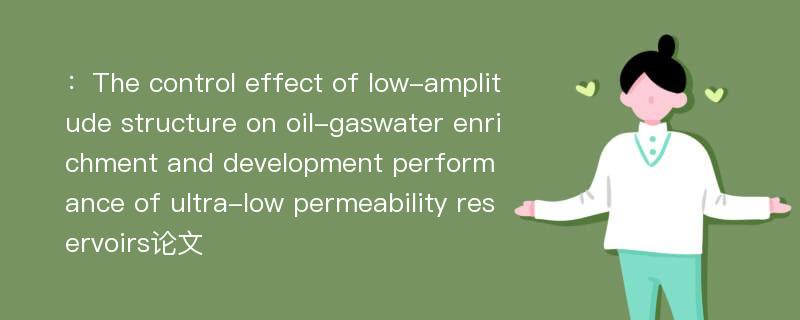
本文主要研究内容
作者(2019)在《The control effect of low-amplitude structure on oil-gaswater enrichment and development performance of ultra-low permeability reservoirs》一文中研究指出:Based on drilling, logging, test production and dynamic monitoring data, the control effects of low-amplitude structure on hydrocarbon accumulation and development performance of ultra-low permeability reservoirs were discussed by using the methods of dense well pattern, multi-factor geological modeling, macro and micro analysis and static and dynamic analysis. The results show that the low-amplitude structure always had a significant control and influence on the distribution and accumulation of original hydrocarbon and water and the evolution trend of water flooding performance in ultra-low permeability reservoirs, and it was not only the direction of oil and gas migration, but also a favorable place for relative accumulation of oil and gas. The controlling effect of low-amplitude structure on ultra-low permeability reservoir mainly depended on its tectonic amplitude and scale; the larger the tectonic amplitude and scale, and the higher the tectonic position of the low amplitude structure, the better the reservoir characteristic parameters, oil and gas enrichment degree and development effect, and the larger the spatial scope it controlled and influenced; water cut and oil well output always fluctuated orderly with the height of the low-amplitude structure; the dynamic response of waterflooding was closely related to the relative structural position of the injection and production wells; the injected water always advanced to the low-lying area of the structure first and then moved up to the high-lying area of the structure gradually; with the continuous expansion of the flooded area, part of the oil and gas in the low-lying part of the structure was forced to be distributed to the high part of the structure, resulting in a new oil and gas enrichment, so that the dynamic reserves of oil wells in the high part increased, and the production capacity remained stable.
Abstract
Based on drilling, logging, test production and dynamic monitoring data, the control effects of low-amplitude structure on hydrocarbon accumulation and development performance of ultra-low permeability reservoirs were discussed by using the methods of dense well pattern, multi-factor geological modeling, macro and micro analysis and static and dynamic analysis. The results show that the low-amplitude structure always had a significant control and influence on the distribution and accumulation of original hydrocarbon and water and the evolution trend of water flooding performance in ultra-low permeability reservoirs, and it was not only the direction of oil and gas migration, but also a favorable place for relative accumulation of oil and gas. The controlling effect of low-amplitude structure on ultra-low permeability reservoir mainly depended on its tectonic amplitude and scale; the larger the tectonic amplitude and scale, and the higher the tectonic position of the low amplitude structure, the better the reservoir characteristic parameters, oil and gas enrichment degree and development effect, and the larger the spatial scope it controlled and influenced; water cut and oil well output always fluctuated orderly with the height of the low-amplitude structure; the dynamic response of waterflooding was closely related to the relative structural position of the injection and production wells; the injected water always advanced to the low-lying area of the structure first and then moved up to the high-lying area of the structure gradually; with the continuous expansion of the flooded area, part of the oil and gas in the low-lying part of the structure was forced to be distributed to the high part of the structure, resulting in a new oil and gas enrichment, so that the dynamic reserves of oil wells in the high part increased, and the production capacity remained stable.
论文参考文献
论文详细介绍
论文作者分别是来自Petroleum Exploration and Development的,发表于刊物Petroleum Exploration and Development2019年04期论文,是一篇关于,Petroleum Exploration and Development2019年04期论文的文章。本文可供学术参考使用,各位学者可以免费参考阅读下载,文章观点不代表本站观点,资料来自Petroleum Exploration and Development2019年04期论文网站,若本站收录的文献无意侵犯了您的著作版权,请联系我们删除。
